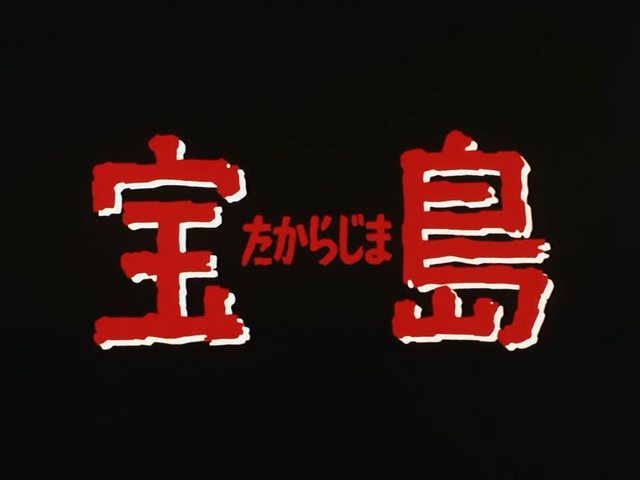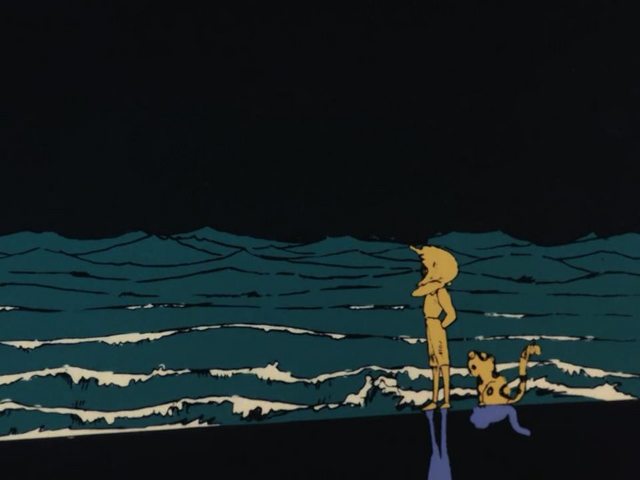Treasure Island (Takarajima): Review (1978, TV, 26 Episodes)
Treasure Island (
Takarajima) is a
1978 anime series directed by the late
Osamu Dezaki, the man who directed animated classics such as
The Rose of Versailles,
Ace o Nerae!,
Oniisama e and
Ashita no Joe (
Tomorrow’s Joe) among many others and
Treasure Island is yet another animated classic that is a part of his legendary resume and is an adaptation of the
Robert Louis Balfour Stevenson novel of the same name. Spanning a total of
26 episodes it tells the story of
Jim Hawkins, a happy go lucky 13 year old boy who lives in England with his widowed mother. They run an Inn together, but ever since his farther died both he and his Mom have struggled running the Inn day in and day out and customers have all but disappeared. The series starts off with them getting a customer on a dark and stormy night. A big man, he is rough and scarred in appearance, a drunkard who requests nothing but rum for both breakfast, lunch and dinner. Eventually his odd behavior piques young
Jim Hawkins interest, and as he becomes more and more aggressive as the days go by, the boy becomes more and more suspicious of the man. Maybe he’s a real pirate? As the series goes on both
Jim and his Mother become more involved in his business as the man who we now learn goes by the name
Billy Bones requests of young
Jim to let him know if he ever spots a one legged man that he fears. On paper
Takarajima comes across as a typical affair, a show about pirates, sea shanties and both treasure and violence but truth be told it’s all wrapped up in a beautiful aesthetic that makes it ever so hard not to keep your eyes on. The 1970’s series shines as brightly today as it did back when it first aired, adorned with striking animation, fantastic, charming character designs and a beautiful soundtrack.
The soundtrack is composed by the late
Kentaro Haneda and as such reminds me heavily of the soundtrack from
SDF Macross, sans
Minmay that is of course. Needless to say it’s a fantastic soundtrack and a highlight of the series. When watching the series it clear that not a lot of music is played throughout the series, however what is utilized is fantastic as each track works its magic during each and every scene, effortlessly telegraphing just what type of scene is commencing. The opening theme,
Takarajima by
Machida Yoshito is a phenomenal piece and really instils a sense of adventure into you as you start each and every episode, with help by
Columbia Yurikago Kai children's choir who add a lot of depth to the theme while the ending,
Chiisana Funanori is equally beautiful, if not more so and is an amazing way to cap off each and every episode. Overall the music is masterful in its composition and implementation, enhancing each and every scene and making everything that much more dramatic, that much more emotional and that much more of an adventure. Top marks here.
Now with audio comes visuals and the animation is also a massive highlight of this series. Painterly is a word that I’d use to describe it. A lot of it is static, not unlike many series from that time period, however not only does it still look breath-taking at times, but that style of animation is also very much a staple of the late
Osamu Dezaki (the director). If you’ve seen any of his other series such as
Ashita no Joe you’ll be instantly accustomed to this. This style of animation has been given many names; the most prominent is the pastel freeze frame however
Dezaki himself dubs it as postcard memories.
Osamu Dezaki to be honest is a very fascinating director that brings along many of his signature techniques across his whole portfolio, and each one almost works as a stamp, branding each and every series in order to make it very clear that this is his work and creates a consistency throughout all of his works. His work visually is unmistakably his and comes across as very striking, because although these techniques are used across the whole medium, nobody can put them to work quite like he can, implementing them effortlessly in each and every episode and each and every scene. It all blends together, not sticking out like a sore thumb.
The art itself is fantastic; however the direction of each and every scene is equally fantastic. He often makes uses of dutch angles in order to disorientate the viewer and high low key lighting, with deep shadows and high contrast lighting in order to create a sense of isolation and loneliness and transitioning from detailed paintings to normal animation and vice versa in order to transition from scene to scene. A myriad of effects and cinematography techniques are utilized in order to foster a unique atmosphere and in the end it’s easy to say that I really enjoy the series from a visual standpoint. A lot of the visual cues can be called cost cutting and time saving measures but in all honestly that’s beside the point because it works tremendously well in
Takarajima and is incorporated wonderfully as they all blend into the beautiful painterly visuals.
Although it’s clear that I love both the visuals and music for
Takarajima, what makes it more enjoyable is that it goes further. One scene in particular, a flash back, reuses a previous scene but inverts all of the colors into negative and its things like this that make the series stand out visually. Being a show called Treasure Island it’s clear that a lot of water is involved, so when the sounds of waves clashing against each other is as riveting as it is here, it’s only so much more enjoyable and immersive as you feel the sun-rays emitting from your screen.
The character designs in
Takarajima are as I mentioned above fantastic. Long John Silver looks like a really manly man, with his blue eyes, flowing hair and huge chiseled chin and young Jim Hawkins looks like a young adventurous boy, as he should, with eyes wide as the world which really represent the characters perfectly. What’s more, it seems like the people at
Gainax agree as in an interview
Nakashima states that with Simon in the epilogue to
Gurren Lagann they took inspiration from
John Silver and it goes deeper, because when pitching
Gurren Lagann itself internally both
Nakashima and
Imaishi wanted to create a series that was “
as manly as Takarajima and Ashita no Joe”. And in the end, looking at them side by side it’s impossible to miss the resemblance.
I’m a massive fan of these types of shows, shows that really embrace their childlike nature with open arms and tell stories that are fun and really make you feel like a kid again, eager to know what happens next.
Takarajima is also very funny which goes a long way, but unlike many series the humor is down to the mannerisms of the characters themselves and is subtle and not in your face. It really does remind me of a series like
SDF Macross.
Takarajima is not a serious series, the story isn’t intricate or full of twists and turns and crazy revelations. It’s straight forward and telegraphs itself clearly, but that’s fine because it’s an immensely fun ride, one that makes you feel like a kid again without treating you like one. People die, and a few episodes in particular played out like a horror film, and yet the whole experience is endearing and fun to watch. The series is not perfect, being a kid’s show it’s not mind-blowing in and of itself, and although not every episode is full of things going on, they all never the less keep you interested and engaged.
In the end,
Takarajima has ended up as one of my favorite series, one with beautiful animation, charming and likeable characters and a great soundtrack that all works together to form a concoction of fun, adventure and excitement. Fifteen men on the dead man's chest...Yo-ho-ho, and a bottle of rum! Drink and the devil had done for the rest...Yo-ho-ho,
9 out of 10
Story: 8
Animation: 9
Sound: 9
Character: 9
Enjoyment: 10
Overall: 9/10


